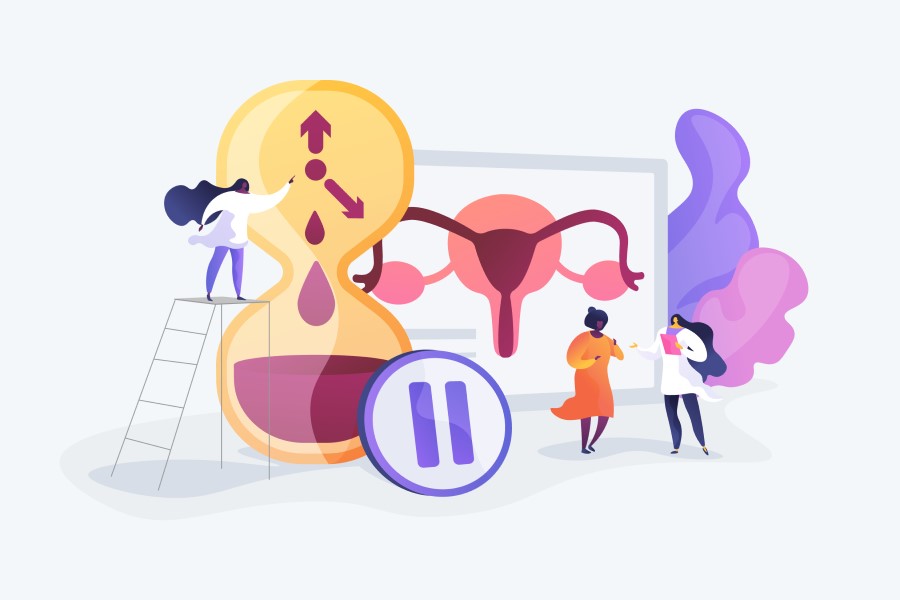10 workplace interventions to improve menstrual and menopausal health and wellbeing

But first, we need to clarify the ‘problem’
The problem is not the menstruating or menopausal (i.e. female) human body. These processes are entirely healthy and normal experiences for the slight majority of humans. Plus, only a minority of menstruating (approximately 10% [1]) or menopausal (approximately 10–20% [2]) people will experience symptoms severe enough to disrupt their daily lives.
The problem is that many employees have limited access to adequate, or ideally, responsive working conditions that take these natural human experiences into account. Plus, women continue to shoulder an unequal share of unpaid childcare responsibilities, on top of paid work, which can negatively affect wellbeing.
So what can employers do to help improve their workforce’s health, wellbeing, productivity and staff retention?
1. Menstrual and menopausal health literacy
Due to inadequate menstruation or menopause education (in schools and medical training), most people know very little about the nature, prevalence of, or effective treatment options for menstrual/menopausal symptoms [3].
This ignorance is not inevitable and it wouldn’t take much to significantly improve our collective level of knowledge. Therefore, a key part of improving menstrual/ menopausal health in the workplace would be to ensure that employers, employees (and their doctors), all have access to high quality information about menstrual/ menopausal health.
2. Access to effective treatment
Most UK workplaces could easily provide free ‘emergency’ period products (eg tampons and pads), ibuprofen (anti-inflammatory medication), heated pads or hot water bottles, hot drinks, and even some healthy snacks. Likewise, for the most common menopausal symptom by far- hot flushes- access to desk fans, cold water, or cold drinks, would be great. Ideally, employees would also have access to a quiet space to rest until mild-moderate symptoms have improved.
In the case of severe cyclical or menopausal symptoms, employees should be supported and encouraged to access quality medical advice and treatment options, as soon as possible. There are several treatment options available, not just hormonal medications/HRT [2].
3. Adequate rest breaks
For workers who menstruate, or are going through the menopause, being able to take a break and access a toilet and clean water is especially important, but all workers would benefit from regular breaks and better sanitary conditions.
Rest breaks have been shown to decrease the likelihood of workplace injury or illness, as well as improving productivity and efficiency [4]. Providing hygienic toilet facilities also reduces the risk of coughs, colds and other infectious illnesses spreading through the workforce [5].
4. Sick leave
Ideally, all workers (regardless of gender) would be able to take short term sick leave without it counting against them in any way [6]. Note- Menstrual/ menopausal symptoms are already covered by sick leave policies in the UK. This entirely avoids the issues caused by having a gender-specific benefit, such as ‘menstrual leave’, or even ‘menopause leave’, which (although well-intentioned) are likely to result in resentment of, and discrimination against, female employees.
Happily, research has shown that “paid sick leave policies are associated with economic benefits for employers, specifically in terms of improved employee productivity, reduced turnover and lower associated hiring and training costs, as well as improved employee morale and loyalty” [7].
5. Flexible working
Evaluations of menstrual policies in the workplace recommend greater flexibility in work practices because most people only need a relatively short amount of time to rest/manage menstrual or menopausal symptoms before being able to return to work [8].
So, being able to work from home (if applicable) or take time out for a portion of the working day, is better than having to take a whole day of leave [8]. Time can be made up at another point, if necessary. If there is a quiet place to rest and cool down, or take medication etc. in the workplace, then the amount of time spent away from work is minimised.
6. Contingency cover
Often, employees are put off taking sick leave because someone will need to cover them and this isn’t always easy to find on short notice [9]. Taking time off can also create resentment from those who are asked to cover the work [9].
It is the responsibility of the employer/manager to resolve this issue. One suggestion is to do so through contingency planning.
7. No sex-specific policies, please!
Global evaluations of employment polices from the past several decades have consistently shown that gender or sex-specific policies (no matter how ‘good’ their intention) end up harming the very people they aim to help [11]. So, no need for menstrual leave, or menopause leave- but perhaps a middle-age gap year/sabbatical policy for all those between 45-55 years old, would be popular? Or changing to a 4-day week for all employees?
The trick is to identify the needs of ‘women’ (and ideally other marginalised groups) and to design policies for all employees that take them into proper consideration. That way, the policy actually helps everyone and does not accidentally make colleagues or employers feel any (more) resentment towards ‘women’ in general (or any other marginalised group).
8. Fair wages/equal job opportunities
It is no coincidence that the countries where menstrual leave has been implemented tend to have relatively large gender pay gaps [11]. Those included in a 2017 OECD report (Organisation for Economic Cooperation and Development) are; India (56%); Korea (37%); Indonesia (34%); and Japan (26%). Note- the OECD country average is 15% [13].
Large gender pay gaps reflect both horizontal and vertical gender segregation. This means that women and men tend to work in different jobs, and those associated with women are paid less [14]. This results in women workers having less power at work and in wider society. Ensuring equal wages and job opportunities would go a lot further than menstrual/menopausal leave in improving gender equality at work, and it wouldn’t accidentally reinforce any menstrual/menopausal/gender myths.
9. More equitable work/life balance
Whilst on average, men work more hours of paid work than women, women continue to shoulder the majority of unpaid reproductive labour, often on top of paid work [15]. What is more, the bigger the gender split between paid and unpaid work, the more likely that everyone ends up working really long hours [16]. It’s basically a lose-lose situation!
So, by implementing policies that restrict (paid) working hours to more sustainably healthy levels (as endorsed by EU legislation, for example [17]), all employees are able to have a better work/life balance. Those who are parents also have more time to spend with their children and to share parenting responsibilities, improving gender equality.
10. Minimum standards for working conditions and labour rights
In the majority of countries that endorse menstrual leave, this specifically refers to improving (or eliminating, if possible) ‘sweatshop labour‘ conditions. In the UK and similar economies, it is about protecting those with ‘zero-hour’ contracts, or other vulnerable working populations such as migrant workers, or anyone forced to work long hours for low pay, or in uncomfortable or dangerous conditions.
Certainly, if we could improve global minimum labour standards regarding (flexible/maximum) work hours, (fair and living) wages, appropriate rest and toilet breaks, health and safety standards (applicable to all workers), sick leave, and equal opportunities, (and stir in a bit of menstrual/menopausal health literacy) there would be absolutely no need for any additional sex-specific ‘leave’ type policy.
The author is Sally King, founder and research director of Menstrual Matters.
This blog is reproduced with the permission of Menstrual Matters to mark World Menopause Day 2019. It has been summarised and adapted by Tsara Crosfill Morton (research intern) and Sally King for REBA.
The original menstrual leave blog series is a summary of a forthcoming book chapter by Menstrual Matters founder, Sally King- “Menstrual leave; good intention, poor solution”, in The Handbook of Gender and Employment Policies. Sage; London
References
[1] Tschudin, S., Bertea, P.C. & Zemp, E. “Prevalence and predictors of premenstrual syndrome and premenstrual dysphoric disorder in a population-based sample” in Archive of Women’s Mental Health (2010) 13: 485.
[2] Cochrane, R, and Currie, H. (2017): "The menopause: benefits and risks of available treatments." Prescriber 28:6 19-28.
[3] This is probably the biggest problem regarding menstrual health- people do not know if what they are experiencing is normal or a sign of a health issue, and their doctor may not know, either (or be aware of evidence-based treatment options for any underlying health problem)… This is why Menstrual Matters exists! For a useful overview, check out this previous blog.
[4] Lombardi, David, A., Jin, K., Courtney, T. K., Arlinghaus, A., Folkard, S., Liang, Y., & Perry, M. J. (2014). The effects of rest breaks, work shift start time, and sleep on the onset of severe injury among workers in the People’s Republic of China. Scandinavian Journal of Work, Environment & Health, 40(2), 146–155. Retrieved here.
[5] Linder, M., & Nygaard, I. (1998). Void Where Prohibited: Rest Breaks and the Right to Urinate on Company Time. Retrieved here.
[6] Sick leave is provided to most workers, unless you are self-employed, temporary, or vulnerable e.g. on a ‘zero hours’ contract. Also, some UK employers use sick leave absences against the employee- e.g. to prevent a pay rise or job promotion. Morally, this should probably count as a type of employment discrimination, but it isn’t something currently covered by the workplace Equality Act (2010).
[7] p44. of Schliwen, A., Earle, A., Hayes, J., & Heymann, S. J. (2011). The administration and financing of paid sick leave. International Labour Review, 150(1), 43–62. Retrieved here.
[8] A Taiwanese menstrual leave evaluation and a UK ‘menstrual flexibility’ company policy review found that most employees did not require more than 30 mins -2 hours away from work to manage/ treat even severe menstrual symptoms;
Chang, C., Chen, F.-L., Chang, C.-H., & Hsu, C.-H. (2011). A preliminary study on menstrual health and menstrual leave in the workplace in Taiwan. Taiwan Gong Gong Wei Sheng Za Zhi, 30(5), 436–450. Retrieved here.
Owen, L. (2018). Menstruation and humanistic management at work: The development and implementation of a menstrual workplace policy. E-Organisations & People (Journal of the Association for Management Education & Development), 25(4), 23–31. Retrieved here.
[9] The above Taiwanese menstrual leave evaluation and UK ‘menstrual flexibility’ company policy review also found that finding cover for an individual’s role was a significant barrier to taking sick leave- leading to chronic ‘presentee-ism’, which is known to reduce productivity.
[10] The UK company ‘menstrual flexibility’ policy used contingency planning to improve short term cover for roles- resulting in improved wellbeing and uptake of sick leave by both men and women employees (see Owen reference above).
[11] Research has found that the gender pay gap for all women (not just mothers) is higher in countries with women-only policies. See;
Mandel, H., & Semyonov, M. (2005). Family policies, wage structures, and gender gaps: Sources of earnings inequality in 20 countries. American Sociological Review.
and Misra, Joya; Michelle Budig; Stephanie Moller (2006). “Reconciliation Policies and the Effects of Motherhood on Employment, Earnings, and Poverty”. Luxembourg Income Study Working Paper Series.
[12] p. 152 in Bacchi, C. L. (1990). Same difference : feminism and sexual difference. Sydney ;Boston: Allen & Unwin.
[13] Based on fig 1.15 in OECD. (2017). A Decade of Social Protection Development in Selected Asian Countries. OECD (Organisation for Economic Cooperation and Development).
[14] p. 218 in Wharton, A. S. (2005). The Sociology of Gender: An Introduction to Theory and Research. Blackwell Publishing.
[15] ILO, & Eurofound. (2019). Working conditions in a global perspective. Retrieved here.
[16] Data from Miranda, V. (2011), “Cooking, Caring and Volunteering: Unpaid Work Around the World”, O.E.C.D. Social, Employment and Migration Working Papers, No. 116, O.E.C.D. Publishing, Paris. Graphs available here.
[17] In EU countries you are not supposed to work more than 48 hours a week on average – normally averaged over 17 weeks. This law is sometimes called the ‘working time directive’ or ‘working time regulations’- for more info see.






